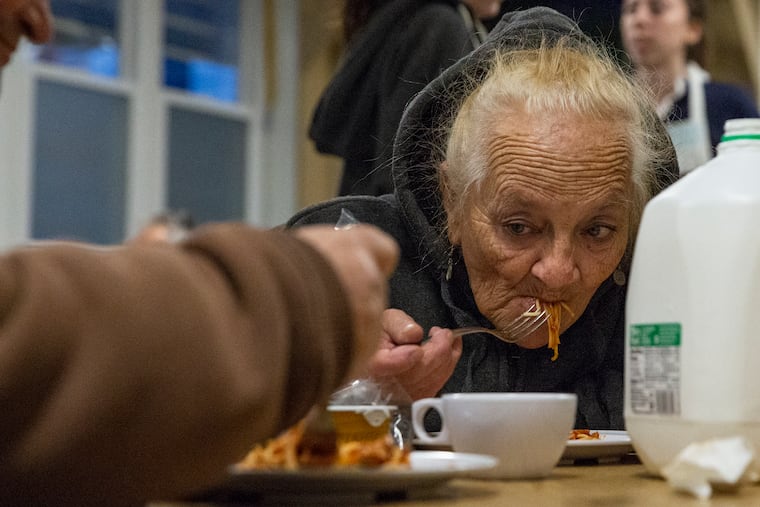Philly could populate Pittsburgh with its hungry | Mike Newall
If all the newly hungry in Philadelphia attended a Phillies game at Citizens Bank Park, they'd fill every seat in the stadium — with another 11,000 people stranded in the parking lot.

At the St. Francis Inn soup kitchen, cook Kelly Canning knows the regulars by name. Some have been coming for years. For her, it's the fresh faces that highlight the depth of Philadelphia's growing hunger crisis — young people in addiction, seniors and families choosing between utility bills and groceries, laborers who can't stretch their paychecks one more meal.
"We still get our regulars," she said Tuesday as she prepared a spaghetti dinner for 325 people, which is standard these days at the crowded inn. "Now, we have a whole new group of people."
St. Francis sits on Kensington Avenue, in the heart of Philly's perfect storm, but the suffering citywide is so severe that it lends itself to a simple, stark shorthand: We are the poorest and hungriest big city in the country, and the epicenter of the urban opioid crisis to boot. This is our reality now.
In fact, it's been our reality for a long time. We keep applying fresh coats of paint onto our city. We sell a success story about a place on the rise, and in many ways we are. But if we don't confront our city's full story, the progress becomes hollow.
As my colleague Alfred Lubrano reported, a nonprofit recently found that nearly 20 percent of Philadelphians were "food insecure," which means they didn't have enough food in the course of a year to lead a healthy lifestyle.
That's 302,685 Philadelphians without enough to eat. We could populate the city of Pittsburgh with our hungry.
And hunger here is on the rise, even as it drops nationally. The number of Philadelphians who worried about their next meal rose by more than 54,000 between the two periods the nonprofit looked at: 2012 to 2014, and 2015 to 2017.
Put it this way: If all the newly hungry in Philadelphia decided to attend a Phillies game at Citizens Bank Park, they'd fill every seat in the stadium — with 11,000 people stranded in the parking lot.
The reason why Philly grows hungrier as suffering eases elsewhere is plain: More Philadelphians live in poverty than in any big city in the country. The city's rate is more than double the national average.
We're a city gripped by inequity — where entire neighborhoods have been neglected for decades, where housing prices rise as good jobs for the working class have never been replaced, as in other postindustrial cities. Where in our biggest industries — meds and eds, as they say — the sort of jobs that are supposed to give people a foothold too often pay wages too paltry to feed a family. We've neglected so many building blocks for so long — schools, neighborhoods, housing stock — that it's harder for our citizens to climb out of poverty. To even get a foot on the ladder. (On top of this, the Trump administration is trying to cut food stamps, because, of course it is.)
Did we put all that in our Amazon pitch?
Maria Kefalas, a professor in the department of sociology and criminal justice at St. Joseph's University, feels like she has been screaming into the ether for years about how Philly could ease so much of its hunger problem if it just pressured its biggest employers — Aramark, Comcast, the hospitals, the universities — to pay their lowest-earning employees a living wage.
Consider that 62 percent of the 90,000 households that the food charity Philabundance serves a week have someone in the home with a job.
Over the years, Kefalas said, the effectiveness of charities like Philabundance and Project HOME "have muted the failed moral leadership of the city's business and political leaders."
City officials say the numbers didn't catch them by surprise. Hunger is what Eva Gladstein, the city's deputy managing director for health and human services, calls a "root problem" — one that undergirds so many municipal failings. And the city is making moves toward the simplest fix — getting more people more cash — with campaigns to increase the minimum wage for city workers and contractors, "Fair Workweek" measures to protect low-income workers and expanded food access programs.
She's right to say it's going to take an all-hands-on-deck approach, with corporate and philanthropic institutions all doing their part. But the city needs to lead that charge.
Because at St. Francis, the line stretches into the gray of the avenue. It's like that these days.
Philadelphia Media Network is one of 21 news organizations producing Broke in Philly, a collaborative reporting project on solutions to poverty and the city's push toward economic justice. See all of our reporting at brokeinphilly.org.